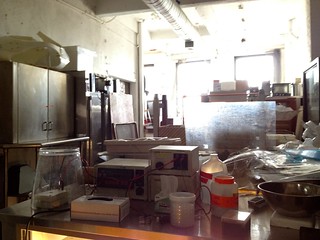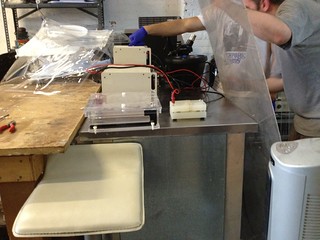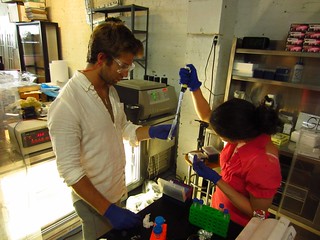Team:NYU Gallatin/Project/Transforming
From 2012.igem.org
NYU Gallatin 2012 iGEM Team
Main menu
- HomeHome of Aseatobacter.Home
- TeamThe brains of the operation.Team
- ProjectLearn more about our project.Project
- PartsOur work with the parts registry.Parts
- ModelingHow we put it all together.Modeling
- NotebookLab notebooks, news, and photos.Notebook
- SafetyOur commitment to safety.Safety
- AttributionsGive credit where credit is due.Attributions
- ProfileOfficial iGEM 2012 profile.Profile
The Project
Transformation

 With regard to transformation, electroporation is well-known for its higher cell wall penetration rate and its efficiency on higher-organism cells, mammalian cells in particular. We used electroporation on E. Coli cells, adapting and improving available electroporation protocols to optimize transformed colony yield.
With regard to transformation, electroporation is well-known for its higher cell wall penetration rate and its efficiency on higher-organism cells, mammalian cells in particular. We used electroporation on E. Coli cells, adapting and improving available electroporation protocols to optimize transformed colony yield.  We hypothesized that corrected voltage and cell preparation procedures would allow us to successfully transform. Acetobacter Xylinum through electroporation. Tests included E.Coli and Acetobacter Xylinum transformation for RFP and GFP expression. Pure Acetobacter Xylinum cultures were also grown in media for several weeks and a chart has been prepared to describe and detail growth patterns. Using a spectrophotometer, light absorbency readings were taken regularly to allow for the collection of daily data. Through this measurement technique, we also determined optimal growth phases for the preparation of Acetobacter Xylinum as an electro-competent cell.
We hypothesized that corrected voltage and cell preparation procedures would allow us to successfully transform. Acetobacter Xylinum through electroporation. Tests included E.Coli and Acetobacter Xylinum transformation for RFP and GFP expression. Pure Acetobacter Xylinum cultures were also grown in media for several weeks and a chart has been prepared to describe and detail growth patterns. Using a spectrophotometer, light absorbency readings were taken regularly to allow for the collection of daily data. Through this measurement technique, we also determined optimal growth phases for the preparation of Acetobacter Xylinum as an electro-competent cell.


Protocols
Modified E. Coli and Acetobacter Electroporation Protocol
Protocol Adapted From Following Paper:
https://docs.google.com/a/brown.edu/folder/d/0B52k0YOxsn7EQk9kc2VxdlI0NTQ/edit?docId=0B9bdNJ3ouX7GSlFlQ0N5S2hBZW8
Materials Needed:
- Ice Cold sterile H20
- Ice Cold 10% Glycerine
- Plasmid
- Bacterial Strain
- Sterile LB Broth
- Sterile SOC Broth
- For Acetobacter: Sterile Acetobacter media.
Materials we used:
- MM194 and JM109 E. Coli strains
- PBR332 plasmid at 5ng/mL concentration
Equipment Used
- Bio-Rad Gene-Pulser Electroporation Machine, Resistor, and Capacitance Extender
- Refrigerated Centrifuge
- Spectrophotometer
Electro-competent Cell Preparation (for 50 transformations)
- Inoculate 5ml liquid LB culture for overnight incubation at 37 degrees with agitation at 225rpm. Use Acetobacter media for Acetobacter cultures instead of LB.
- Next day, pour 27mL liquid LB into 4 separate 50mL tubes and pre-heat to 37degrees.
- To each tube, add 1.25mL of overnight culture.
- Incubate the 50mL tubes with agitation (225rpm 37degrees)
- Incubate until an A600 absorbance reading of approximately 0.4 is reached, this should take approximately one hour. Acetobacter cultures, which have a much slower growth rate, may be incubated overnight if absorbance readings are not reached.
- Once bacterial cultures reach desired density, take them out of incubation and put them in an ice bath for 30 minutes.
- After cooling, spin the tubes in a refrigerated (4degC) centrifuge for 12min at 4100rpm.
- Pour off supernatant, taking care not to disturb the pellet and re-suspend bacteria pellet in 25mL ice-cold sterile water. Use pipette to accomplish this; do not use a vortex machine.
- Centrifuge again for 12 minutes at 4100 rpm and 4 degrees C temp
- Pour off supernatant again, re-suspend pellet in 4mL ice-cold sterile water and transfer suspended mixture to 15mL tube.
- Centrifuge again for 12 minutes at 4100 rpm and 4 degrees C
- Pour off water and re-suspend pellet in 2mL ice cold 10% glycerin
- Centrifuge for 12 Minutes at 4100 rpm and 4 degrees C
- Aspirate as much supernatant as possible using a micro-pipette and re-suspend pellet in 2mL ice cold 10% glycerin.
- Store samples on ice for immediate use or freeze down 40ul aliquots at -80degC.
Note: Centrifuging has been tried at an extra 100rpm speed for 13 minutes successfully, supernatant was easier to discard.
Electroporation Protocol
- Use 40mL aliquots of the suspended bacteria for each transformation.
- Add 2mL of plasmid (we used PBR322 at 5ng/mL) to 40mL of bacteria suspension and mix
- Transfer sample to ice cold 1mm gap electroporation cuvette
- Remove all moisture from outside of cuvette with kimwipe, this is important to prevent electrical arcing. Note: If an arc is observed, then your sample most likely did not successfully transform!
- Set electroporation machine to 2.5kV current with 200W resistance and 25mF capacitance
- Using Bio-Rad Gene Pulser: Insert cuvette into cuvette holder, making sure electrodes on the cuvette are touching those in the holder. Make sure cuvette holder is behind a Plexiglas safety shield.
- Hold down the two red buttons on the gene pulser until you hear a beep, then release, this should indicate that a successful charge was dispersed
- Using warm SOC media, quickly transfer contents of cuvette and place them into a sterile 15mL tubes, containing 1mL of warm SOC media.
- Incubate the culture for 1 hour at 37 degrees with gentle agitation
- After incubation, take 200mL of the sample and plate onto appropriate agar, use beads to spread the sample around the plate


Transformation Lab Notes
| Team | Date | Note |
|---|---|---|
|
Sarah Transformation |
Aug/10/2012 |
|
|
Sarah Transformation |
Aug/07/2012 |
|
|
Sarah Transformation |
Aug/04/2012 |
|
|
Sarah Transformation |
Aug/03/2012 |
|
|
Sarah Transformation |
Aug/02/2012 |
|
|
Sarah Transformation |
Aug/01/2012 |
|
|
Sarah Transformation |
Jul/30/2012 |
|
|
Sarah Transformation |
Jul/20/2012 |
|
 "
"

















